Advertisements
Advertisements
प्रश्न
Find the equivalent capacitances of the combinations shown in figure between the indicated points.
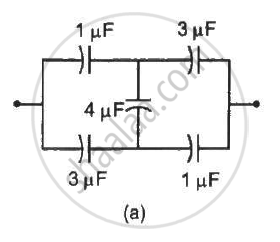

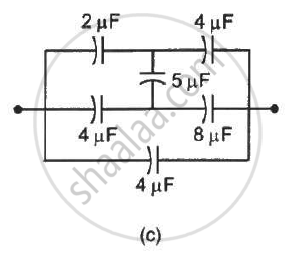
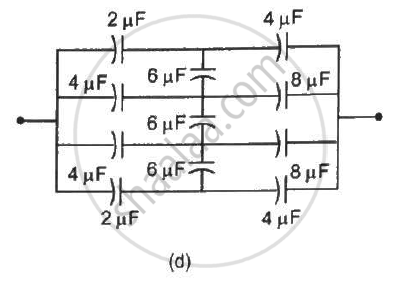
उत्तर
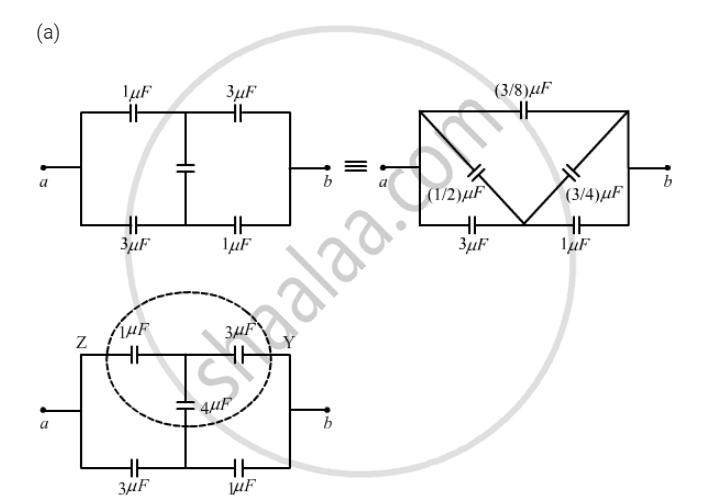
Applying star-delta conversion in the part indicated in the diagram.
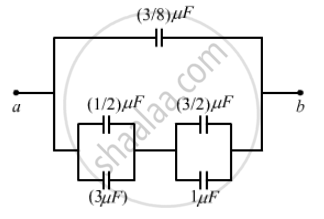
The Capacitance of the `C_1` is given by
`C_1^' = (C_2C_3)/(C_1+C_2+C_3)`
`C_2^' = (C_1C_3)/(C_1+C_2+C_3)`
`C_3^' = (C_1C_2)/(C_1+C_2+C_3)`
⇒ `C_1'^ = (3 xx 4)/(1+3+4) = 12/8 "uF"`
⇒ `C_2^' = (1 xx 3)/(1+3+4) = 3/8 "uF"`
⇒ `C_3^' = (1 xx 4)/(1+3+4) = 4/8 "uF"`
Thus, the equivalent circuit can be drawn as :

Therefore, the equivalent capacitance is given by
`C_(eq) = 3/8 + [((3+1/2) xx (3/2+1))/((3+1/2)+(3/2+1))]` = `3/8 + 35/24 = (9+35)/24 = 11/6 "uF"`
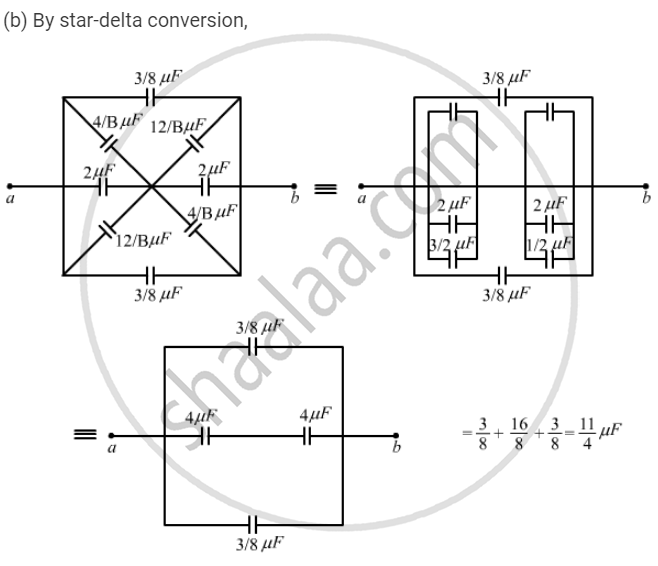
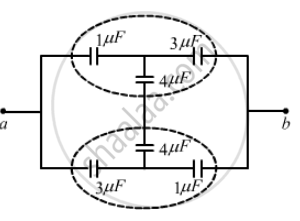
`1+1 = 2 "uF"`
(c)
It is a balanced bridge.
Therefore, the capacitor of capacitance 5 μF can be removed.
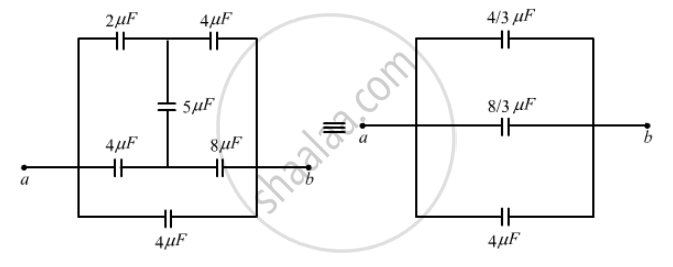
Cef = `4/3+8/3+4 = 8 "uF"`
The capacitance of the two branches are :
`C_1 = (2 xx 4)/(2+4) = 4/3 uF`
`C_2 = (4 xx 8)/(4+8) = 8/3 uF`
∴ Equivalent capacitance = `4/3 + 8/3 + 4 = 8 "uF"`
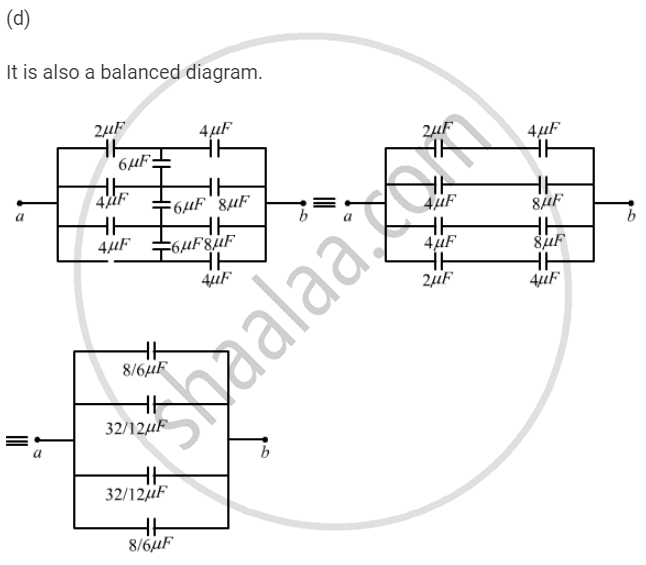
It can be observed that the bridges are balanced.
Therefore, the capacitors of capacitance 6 μF between the branches can be removed
The capacitances of the four branches are :
`C_1 = (2 xx 4)/(2+4) = 4/3 uF`
`C_2 = (4 xx 8)/(4+8) = 8/3 uF`
`C_3 = (4 xx 8)/(4+8) = 8/3 uF`
`C_4 = (2 xx 4)/(2+4) = 4/3 uF`
∴ Equivalent capacitance
= `4/3 + 8/3 + 8/3 + 4/3`
= ` 8 "uF"`
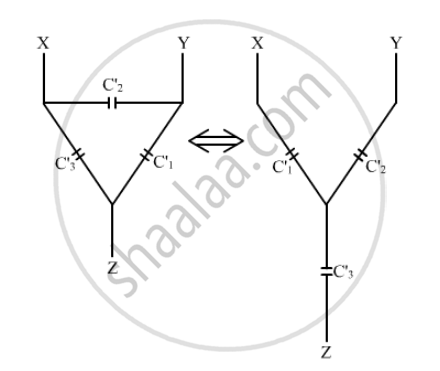
APPEARS IN
संबंधित प्रश्न
Obtain the equivalent capacitance of the network in Figure. For a 300 V supply, determine the charge and voltage across each capacitor.
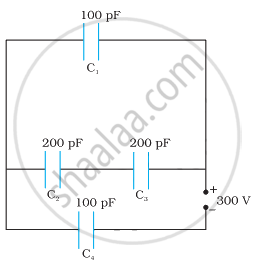
Two identical parallel plate capacitors A and B are connected to a battery of V volts with the switch S closed. The switch is now opened and the free space between the plates of the capacitors is filled with a dielectric of dielectric constant K. Find the ratio of the total electrostatic energy stored in both capacitors before and after the introduction of the dielectric.
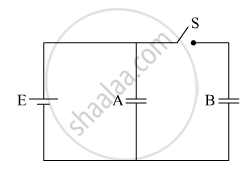
Two identical capacitors of 12 pF each are connected in series across a battery of 50 V. How much electrostatic energy is stored in the combination? If these were connected in parallel across the same battery, how much energy will be stored in the combination now?
Also find the charge drawn from the battery in each case.
A capacitor of unknown capacitance is connected across a battery of V volts. The charge stored in it is 360 μC. When potential across the capacitor is reduced by 120 V, the charge stored in it becomes 120 μC.
Calculate:
(i) The potential V and the unknown capacitance C.
(ii) What will be the charge stored in the capacitor, if the voltage applied had increased by 120 V?
A parallel-plate capacitor has plate area 25⋅0 cm2 and a separation of 2⋅00 mm between the plates. The capacitor is connected to a battery of 12⋅0 V. (a) Find the charge on the capacitor. (b) The plate separation is decreased to 1⋅00 mm. Find the extra charge given by the battery to the positive plate.
Three capacitors having capacitances 20 µF, 30 µF and 40 µF are connected in series with a 12 V battery. Find the charge on each of the capacitors. How much work has been done by the battery in charging the capacitors?
Find the charge supplied by the battery in the arrangement shown in figure.
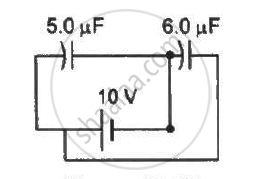
Each of the capacitors shown in figure has a capacitance of 2 µF. find the equivalent capacitance of the assembly between the points A and B. Suppose, a battery of emf 60 volts is connected between A and B. Find the potential difference appearing on the individual capacitors.
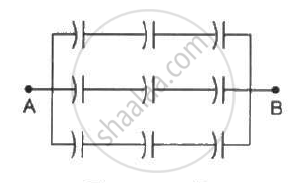
Find the equivalent capacitance of the system shown in figure between the points a and b.

A capacitor of capacitance 10 μF is connected to a battery of emf 2 V. It is found that it takes 50 ms for the charge of the capacitor to become 12.6 μC. Find the resistance of the circuit.
A parallel-plate capacitor of capacitance 5 µF is connected to a battery of emf 6 V. The separation between the plates is 2 mm. (a) Find the charge on the positive plate. (b) Find the electric field between the plates. (c) A dielectric slab of thickness 1 mm and dielectric constant 5 is inserted into the gap to occupy the lower half of it. Find the capacitance of the new combination. (d) How much charge has flown through the battery after the slab is inserted?
A sphercial capacitor is made of two conducting spherical shells of radii a and b. The space between the shells is filled with a dielectric of dielectric constant K up to a radius c as shown in figure . Calculate the capacitance.
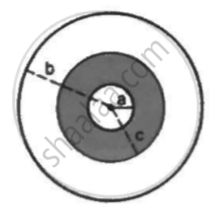
An air-filled parallel-plate capacitor is to be constructed which can store 12 µC of charge when operated at 1200 V. What can be the minimum plate area of the capacitor? The dielectric strength of air is `3 xx 10^6 "Vm"^-1`
Three capacitors are connected in a triangle as shown in the figure. The equivalent capacitance between points A and C is ______.

Obtain the expression for energy stored in the parallel plate capacitor.
A parallel plate capacitor is filled by a dielectric whose relative permittivity varies with the applied voltage (U) as ε = αU where α = 2V–1. A similar capacitor with no dielectric is charged to U0 = 78V. It is then connected to the uncharged capacitor with the dielectric. Find the final voltage on the capacitors.
The material filled between the plates of a parallel plate capacitor has a resistivity of 200Ωm. The value of the capacitance of the capacitor is 2 pF. If a potential difference of 40V is applied across the plates of the capacitor, then the value of leakage current flowing out of the capacitor is ______.
(given the value of relative permittivity of a material is 50.)
A capacitor of capacity 2 µF is charged to a potential difference of 12 V. It is then connected across an inductor of inductance 0.6 mH. The current in the circuit at a time when the potential difference across the capacitor is 6.0 V is ______ × 10-1A.
Current versus time and voltage versus time graphs of a circuit element are shown in figure.
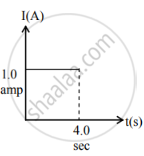 |
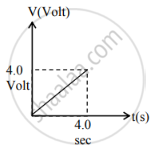 |
The type of the circuit element is ______.
